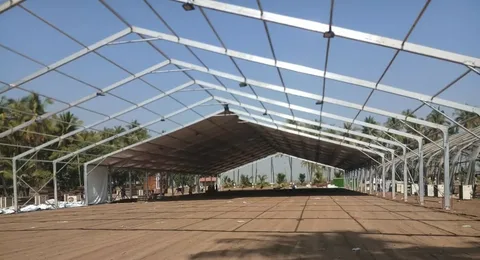German hangar tents, often referred to as industrial or event tents, are robust, spacious structures designed to meet various commercial and recreational needs. Unlike conventional tents, these structures boast an architectural framework capable of enduring harsh weather conditions, making them ideal for long-term use. Their design is heavily influenced by both functionality and aesthetics, with a focus on maximizing usable space while ensuring stability. For those interested in quality and efficiency, a trusted supplier like Woodpeckers Global can be accessed here. (Visit: German Hangar Tents)
The significance of German hangar tents extends far beyond their impressive exteriors. These tents serve as multifunctional spaces suitable for various applications, including temporary warehousing, sporting events, exhibitions, and large gatherings. With a heritage steeped in engineering excellence, the German approach to tent design emphasizes durability and innovation, making these structures a popular choice across diverse industries worldwide.
Key Aspects and Benefits of German Hangar Tents
When considering the adoption of German hangar tents, exhibition stall design and fabrication it’s vital to understand the standout features that set them apart from other types of temporary structures.
First and foremost is their modular design. German hangar tents can be easily customized to different specifications, allowing businesses to choose the shape and size that best fits their requirements. This adaptability means that they can be reconfigured for different events or purposes, making them a versatile investment.
Another critical aspect is the construction material. Typically made from high-quality, weather-resistant fabrics, these tents are designed to withstand a range of environmental conditions. Reinforced seams and durable frames ensure long-term performance, further contributing to their appeal as a cost-effective solution.
One real-world example of these tents in action can be found at major events such as trade shows and music festivals. For instance, in Germany, the annual Oktoberfest utilizes large German hangar tents to accommodate thousands of visitors, providing shelter and comfort while creating a festive atmosphere. Similarly, various automotive and aerospace companies have employed these tents to create temporary manufacturing facilities, showcasing their flexibility in both industrial and commercial contexts.
From a logistical standpoint, German hangar tents also offer significant advantages. Their quick and easy setup reduces the labor hours required for event planning, allowing organizers to focus more on execution rather than logistics. Additionally, many of these tents are portable, meaning they can be disassembled and moved to different locations as needed.
Addressing Challenges and Misconceptions
Despite their many advantages, misconceptions about German hangar tents still exist, often deterring potential users. One common misunderstanding is that these tents are only suitable for temporary use or that they lack the structural integrity of permanent buildings. In reality, many German hangar tents are designed for long-term utilization, gaining acceptance in industries where safety and durability are non-negotiable.
Another challenge lies in the perception of cost. While the initial investment in a high-quality German hangar tent may seem steep, the long-term benefits—such as reduced maintenance, adaptability, and potential for multiple uses—can make them an economical choice. To overcome this misconception, potential buyers should conduct a comprehensive cost-analysis comparison versus traditional building structures, factoring in labor costs, setup times, and potential income generation from using the space for events.
Practical Advice for Effective Implementation of German Hangar Tents
Understanding how to effectively implement German hangar tents can enhance the overall experience and maximize their utility. Here are some practical tips for potential users:
- Clearly Define Needs: Before purchasing a tent, organizations should assess their specific needs. Consider the size, height, and layout required based on the expected number of guests or equipment. This initial analysis will guide the purchasing decision and optimize space usage.
- Consult with Experts: Engaging with suppliers or consultants specialized in German hangar tents can provide valuable insights. They can recommend the best designs and materials for your specific application based on industry standards and experiences.
- Plan for Location: The site choice is crucial when setting up a hangar tent. Ensure that the terrain can support the tent’s structure and that there are no significant obstructions. Assess access points for vehicles and pedestrian flow to maximize efficiency during events.
- Consider Permits: Depending on the location and intended use, you may need specified permits or compliance with local regulations. Prioritizing legal aspects can mitigate potential issues later.
- Maintenance and Care: Regular checks for wear and tear during use will ensure the longevity of the tent. Clean and properly store the tent during off-seasons to maximize its life expectancy.
- Adapt and Innovate: Finally, embrace the versatility of hangar tents by considering multiple uses. From hosting corporate events to serving as seasonal warehousing, flexibility will lead to increased returns on investment.
In conclusion, German hangar tents stand as practical solutions in the modern landscape, combining functionality, durability, and versatility. By understanding their benefits, addressing misconceptions, and implementing them effectively, businesses and event organizers can harness their full potential to create unforgettable experiences and sustain operational efficiency.


